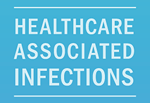
Healthcare-associated infections (HAI) are infections acquired by patients during the course of receiving treatment for other conditions within a healthcare setting.
The CDC estimates that on any given day, 1 in 31 hospital patients has an HAI (an infection acquired while being treated in a medical facility). HAIs can have devastating effects on physical, mental/emotional, and financial health. In addition, they cost billions of dollars in added expenses to the healthcare system.
Research suggests that a growing number of HAIs are caused by pathogens (germs) that are resistant to the antimicrobial drugs typically used to fight them.
Prevalence and Reporting
A CDC study has estimated that 3.2% of hospitalized patients in 2014 were affected by a healthcare-associated infection, a significantly lower percentage than observed in a survey conducted in 2011.These results provide evidence of national success in preventing HAIs, particularly surgical-site and urinary tract infections. However, there was no significant reduction in the prevalence of pneumonia or C. difficile infection, or in the percentage of patients with HAIs who died during their hospitalization. There is still work to be done to prevent these types of infections and reduce mortality among patients with HAIs.
U.S. healthcare facilities are required to report certain HAIs to the Centers for Medicare and Medicaid Services (CMS) via the National Healthcare Safety Network (NHSN). In 2014, MSDH started requiring all healthcare facilities that must report to CMS to allow MSDH access to their data. These facilities include acute care facilities (ACF), long-term acute care (LTAC) facilities, outpatient hemodialysis centers, ambulatory surgery centers (ASC), and inpatient rehabilitation facilities (IRF).
HAI Prevention Goals and the HHS HAI Action Plan
The United States has made significant progress toward our collective goal of eliminating HAIs, and as a result healthcare in the U.S. is safer now than it was even 10 years ago. Building upon this success and continuing toward the elimination of HAIs is critical.
In an effort to lower HAIs and promote better health, the U.S. Department of Health and Human Services (HHS) has set national goals for all HAIs in acute care facilities. These goals are part of the National Action Plan to Prevent Health Care-Associated Infections: Road Map to Elimination (HAI Action Plan). The year 2015 marked the start of new five-year (2015-2020) goals of the HAI Action Plan. The new targets use data from calendar year 2015 as a baseline. These target goals for reduction of healthcare-associated infections are ambitious, but achievable.
Along with targets for HAIs, as part of HHS's Healthy People 2020 initiative, the following additional objectives have been set: to raise healthcare personnel influenza vaccination rates (Phase 2), reduce HAIs in long-term care facilities (Phase 3), and improve antibiotic stewardship (Phase 4).
Target Goals and Progress
Target goals and progress made by 2016 (compared to the new 2015 baseline) are shown below.
| Measure | Progress made by 2016 | 2020 Target |
| CLABSI | 10% reduction | 50% reduction |
| CAUTI | 6% relative reduction | 25% reduction |
| Invasive MRSA | 8% reduction | 50% reduction |
| Hospital-onset MRSA | 6% reduction | 50% reduction |
| Hospital-onset CDI | 7% reduction | 30% reduction |
| SSI | Data pending release | 30% reduction |
| Clostridium difficile hospitalizations (HCUP) | Data pending release | 30% reduction |
HAIs Monitored by MSDH
The following types of infections are followed by MSDH via NHSN, along with healthcare personnel influenza vaccination data.
- central line-associated bloodstream infections (CLABSI)
- catheter-associated urinary tract infections (CAUTI)
- surgical site infections from colon surgeries (SSI:Colo)
- surgical site infections from abdominal hysterectomies (SSI:Hyst)
- Methicillin-resistant Staphylococcus aureus (MRSA) bacteremia
- Clostridium difficile infections (CDI)
Along with these infections, the List of Reportable Diseases and Conditions includes the following drug resistant organisms that are commonly associated with the healthcare setting.
- Vancomycin-resistant Enterococcus (VRE)
- Carbapenem-resistant Enterobacteriaceae (CRE)
- Vancomycin-resistant Staphylococcus aureus (VRSA)
- Vancomycin-intermediate Staphylococcus aureus (VISA)

